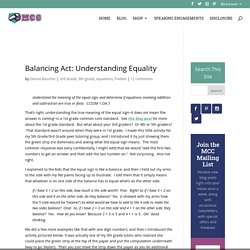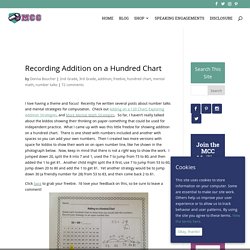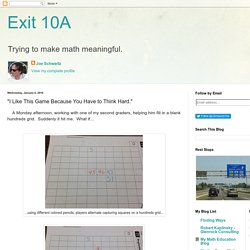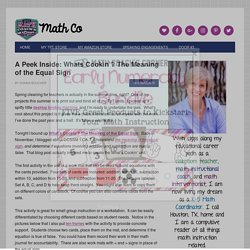

The Meaning of the Equal Sign. Ask a kiddo who has just written 2 + 3 = 5 if it’s okay to write it 5 = 2 + 3 and you’re likely to get an emphatic NO!

Enter common core standard 1.OA.7: Understand the meaning of the equal sign, and determine if equations involving addition and subtraction are true or false. For example, which of the following equations are true and which are false? 6 = 6, 7 = 8 – 1, 5 + 2 = 2 + 5, 4 + 1 = 5 + 2. Twitter. Twitter. Twitter. Exploring Equality and Composing Numbers. I’ve been working with my Firsties on the following TEK: 1.2(A) recognize instantly the quantity of structured arrangements Although it is not mentioned in the TEK, the mathematical word for this skill is subitizing.

The dot patterns on dice and dominoes are very common and easily recognizable, so they are perfect for practicing this standard. I based my lesson on an activity that had students turning over dominoes, subitizing the two dot patterns shown, and stating the sum. The subitizing part they had no problem with. Counting on I wanted to build on what they could do, which was subitize the dot patterns. Balancing act. Second Grade Math Menu Board 2 -TELLING TIME.docx. Decomposing Numbers Into Three Parts. I’ve been working with my Firsties on composing and decomposing numbers, and we are currently working on combinations for eight.

I decided to take it in a different direction this week and work on decomposing into three parts, so I made a part/whole mat with three parts. The lesson started as I handed out the materials. I handed out the part/whole mats, and I gave the first student a handful of teddy bear counters, which turned out to be 5. How many bears do you have? Five. The Importance of 10. Yesterday, I posted about effective fact practice.

Developing automaticity with addition and subtraction facts begins with subitizing, which is why it’s so important that our Kinder babies get a lot of practice with that skill. The next building building block is knowing combinations for 5 and 10. If a student has instant recall of 3 + 7, it sets the stage for knowing 4 + 7. That’s the idea behind teaching facts with a strategy-based approach. Our kindergarten student are brilliant mathematicians. Just look at the work they are doing □… CRA for Composing and Decomposing Numbers. Okay, I’m having trouble finding different ways to say “composing and decomposing numbers” in my post titles! But seriously, it’s just THAT important, so I keep writing about it. Our Kinders and Firsties should be doing these types of activities extensively, so it’s important to find lots of different ways to approach the skill.
Today I present Clothespin Count. Students use strips that have dots showing 5 (pictured below) through 10. Choose the number that your kiddos need to work on. Like the number cards shown in the pictures? Balancing Act: Understanding Equality. Understand the meaning of the equal sign, and determine if equations involving addition and subtraction are true or false.

CCSSM 1.OA.7 That’s right, understanding the true meaning of the equal sign–it does not mean ‘the answer is coming’–is a 1st grade common core standard. See this blog post for more about the 1st grade standard. But what about your 3rd graders? Or 4th or 5th graders? I explained to the kids that the equal sign is like a balance, and then I held out my arms to the side with my flat palms facing up to illustrate. Recording Addition on a Hundred Chart. I love having a theme and focus!

Recently I’ve written several posts about number talks and mental strategies for computation. Check out Adding on a 120 Chart, Exploring Addition Strategies, and More Mental Math Strategies. So far, I haven’t really talked about the kiddos showing their thinking on paper–something that could be used for independent practice. "I Like This Game Because You Have to Think Hard." A Monday afternoon, working with one of my second graders, helping him fill in a blank hundreds grid.

Suddenly it hit me. Thank you @gregtangmath for the idea to have my students notice 1 compared to 10, compared to 100, compared to 1,000. Such a better visual than the cube. @RuckerRocks… I was AMAZED at how quickly my students could “shift” numbers to make them easier to subtract! This strategy is □! Thanks @gregtangmath! #leadthewaylf… Episode #38: How to Move Beyond Answer Getting. A Math Mentoring Moment - Make Math Moments.
First grade is building numbers and writing number sentences using ten frames. We’re working on mastering our math facts! @gregtangmath #d124inspire #d124achieve #d124empower… Measurement — Playful Invitations. Last summer we visited a Llama farm in rural Minnesota.

My children had the opportunity to be up close and personal with these gentle creatures. As my two year old ran around the farm, she zeroed in on a baby Llama, hugging and petting it’s head and neck, exclaiming “you’re so tiny” and “you’re so little.” Eventhough, the baby Llama was bigger than my daughter (so not exactly tiny), by comparison to the mama, this one was small. Seeing the baby next to its mother gave her perspective to determine a difference in size. But what if you can’t compare objects directly? To compare objects, children begin by using nonstandard units (“My table is more than four hands long”) and then move to using standard units (“The table is almost three feet long”).
How to Use the Blog Posts. Freebie for Composing and Decomposing Numbers. A Mathemagician's Game for Making Ten. Teaching for Deep Understanding. Ten More/Ten Less Game. This game for practicing ten more/ten less comes from the wonderful book, Common Core Math in Action (K-2), by Catherine Jones Kuhns and Marrie Lasater. Kuhns is also the author of a terrific book on activities for combinations to 10. Check out this blog post for a game from that book. This post contains affiliate links, which simply means that when you use my link and purchase a product, I receive a small commission. There is no additional cost to you, and I only link to books and products that I personally recommend. Tonight’s game is Row, Row, Row by Ten.
Visuals Make EVERYTHING Clear. The Equal Sign: What It Really Means. A Tweet I read a few days ago led me to a blog post by Nancy Q.

Smith titled Equality. In her post, Nancy talks about helping her first graders understand the meaning of the equals sign. The blog reminded me of one of the Starting Points I included in the current fourth edition of About Teaching Mathematics. It’s titled “The Equal Sign: What It Really Means,” and this blog is an excerpt, focusing mostly on the section I included that addresses how I use the children’s book, Quack and Count by Keith Baker, in kindergarten and grade 1. Students love Quack and Count. My typical lesson plan is first to read the book just for students to enjoy. The first time I taught the lesson with this change gave me a firsthand experience with what the research reported. “No,” he said, “you wrote it backwards. Tub game-working on our combinations to 10! @bstockus @EMathRRISD @forestnorth…
A Peek Inside: Whats Cookin'? The Meaning of the Equal Sign. Spring cleaning for teachers is actually in the summer time, right?

One of my projects this summer is to print out and bind all of my TpT units. I picked up a spiffy little desktop binding machine, and I’m ready to undertake the task. What’s cool about this project is it gives me a chance to refamiliarize myself with the work I’ve done the past year and a half. It’s been a whirlwind! Tonight I bound up What’s Cookin’? The first activity in the unit is a work mat that can be used to build equations with the cards provided. The Equal Sign: What It Really Means.